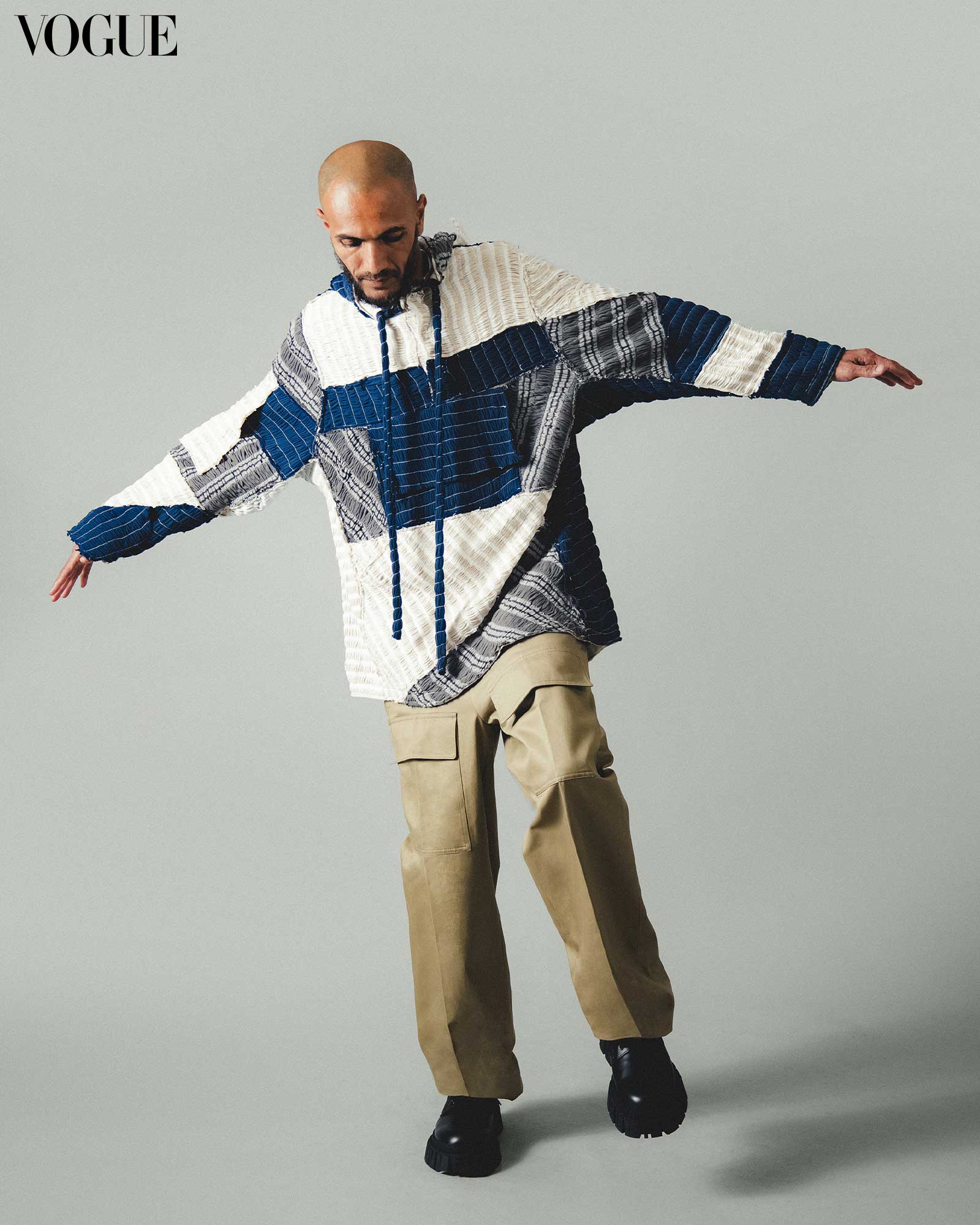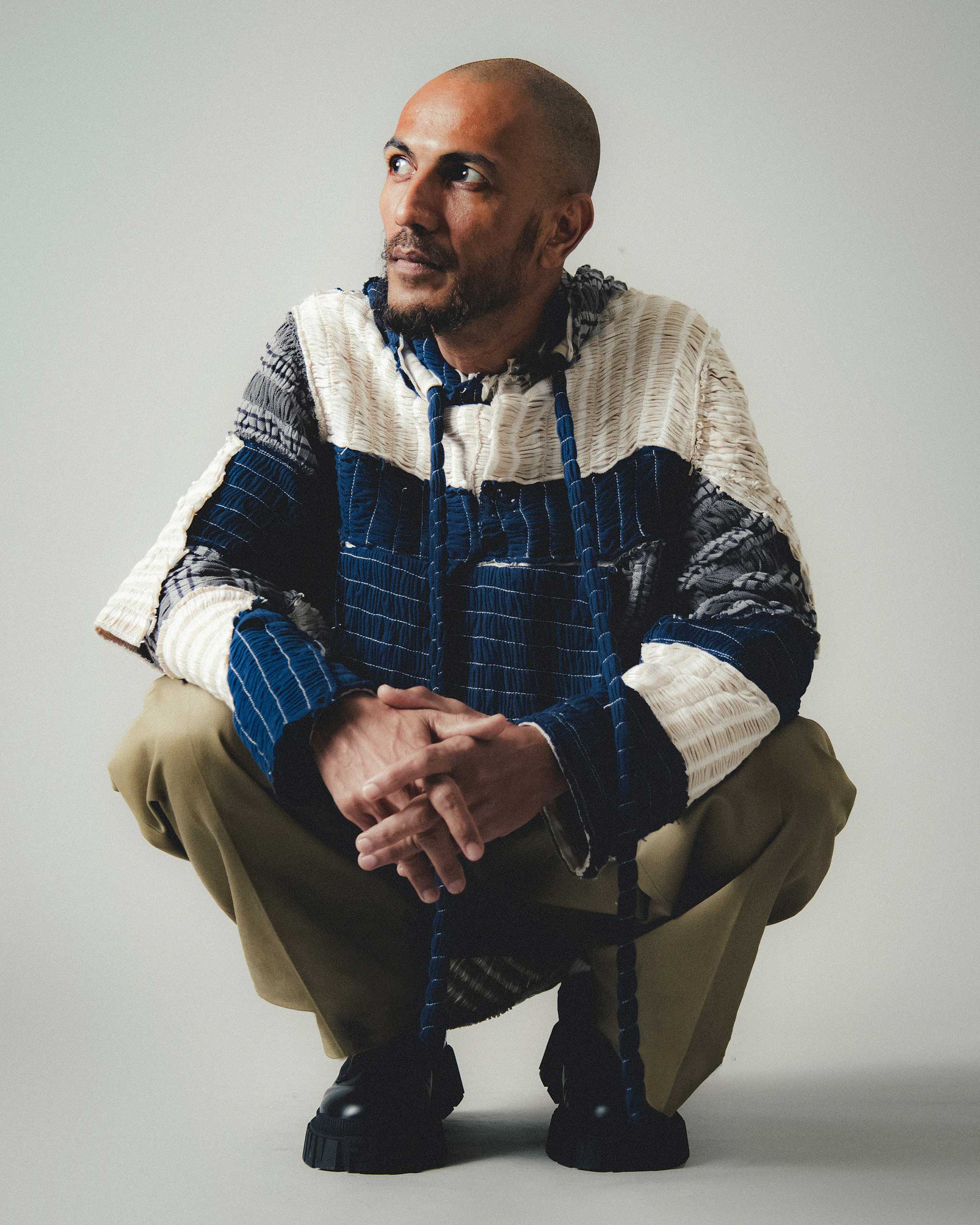Photographed by Joseph Bermudez for the May 2024 Issue of Vogue Philippines.
Morobeats founder DJ Medmessiah talks to Vogue Man about a childhood in Zamboanga colored by musicality, his shift from rapping to producing, and the Mindanaoan approach to hip-hop: “Some create music based on algorithms, which is very dangerous for me. To me, it’s better to create music based out of your feelings.”
Mindanao rests on the Sulu archipelago off Southwestern Philippines, cocooned by the Celebes and Sulu seas. The island chain comprises a serpentine arc around the country’s southernmost tip and is home to the 13 Muslim-majority ethnolinguistic Austronesian group known as the Bangsamoro or the Moro people.
While the Moro people are dispersed across the entirety of Mindanao, the Sulu Archipelago in particular is the ancestral domain of the Tausug, whose name means “people of the current.” The transitory nature of being a culture at the mercy of the seas lends a sense of determinism to the Tausug people. At least that much is clear in veteran producer, rapper, and founder of music collective and independent label Morobeats, DJ Medmessiah.
“In Mindanao, by heart, we believe we are Moros, and we are all just Filipinos on paper,” he says. “We have our pride of representing Mindanao. But at the end of the day, our goal is to be understood. To present different people, different races, and different tribes.”
Born in Algeria to a Tausug-Maguindanaon father and a Moroccan mother, DJ Medmessiah, or Mohammed Bansil, spent his first three years in France before settling in Pagadian, Zamboanga del Sur. Growing up in that city, Mohammed was exposed to the innumerable ways one could tell a story, and how one could hold an audience’s attention from an early age.

After starting out as a young breakdancer in the 1990s, he gained interest in learning how to DJ after watching Disco Mix Club (DMC) competitions. These are largely considered as an institution for serving as a platform wherein DJs battled for legitimacy.
“I said to myself, I wanted to be like those guys. Then I started practicing in a club in Zamboanga City,” he recalls. After practicing on his own and learning from peers, he visited Manila. His real hip-hop education ensued in the now-defunct club of Heartbeat Disco on Quezon Avenue. There, he learned the art of rapping, sharpening his DJ-ing skills into a craft, and collaborating with musical group Vibe Station.
“Of course I couldn’t record yet. It was not like nowadays where you have a computer and you can just record. Before, you needed to really prove yourself, especially me!” he admits, “I was coming from Zamboanga. I was a stranger in Metro Manila.”
When Bansil learned to make beats, “that was it. I fell in love. I said, I don’t want to be a rapper anymore. I just want to stay behind the scenes. Rappers, they come and go. Producers stay.” He says that there was no particular eureka moment for his shift to production, but rather, the feeling of piecing together the backbone of a track: “You’re not that famous, but you’re more behind everything.”
After holding multiple streams of income through the establishment of a Moroccan-Western fusion restaurant, working in an airline, working as a professional hype man, and balancing production work throughout his career, even enjoying a brief affair with noontime television through a reggaeton-inspired Chavacano rap hit that got featured on the likes of Wowowee and It’s Showtime, DJ Medmessiah had yet to give up the day job entirely.
“Rap is not really a stranger to the Philippines, especially in the southern areas. It’s basically how we tell stories.”
In 2014, he officially founded Morobeats, taking on the challenge of straddling the lines between businessman, producer, and mentor to a slew of budding young rappers in an increasingly saturated market. Its catalog of Filipino artists include Tha Wizard, Dizzy D of H20 Klann, Prophecee, Malik, Teemo, Naus, JMara, and Bansil’s daughters, Fateeha and Miss A. The independent label employ a disarmingly raw take on all facets of their production.
Often, DJ Medmessiah will livestream his beatmaking sessions, with his full drum machine and kulintang set up on display. Later in the afternoon, Morobeats has completed the song and in one swift take as the sun sets, a music video has been filmed in their local neighborhood.
DJ Medmessiah is schooled in the discipline of hip-hop in its purest form. A premium on authenticity, style, and work ethic over natural talent. Hip-hop after all, is a genre that relishes in the underdog’s success. It’s a genre that makes heroes out of men.
“I think, for now, the industry is more inclusive. It’s not like before, where if you’re coming from Mindanao, you’re sacrificing so much just to be here,” he explains.
The ephemerality of today’s media landscape that poses virality as a measure of success is the very approach Morobeats is challenging, and DJ Medmessiah is critiquing in particular: “Some create music based on algorithms, which is very dangerous for me. To me, it’s better to create music based out of your feelings.”

Hip-hop, more crucially, is a genre that possesses geographical axis points that root its rich culture in its specific context. Brooklyn has Biggie. Tupac has East Harlem. The Mindanaoan approach to hip-hop, in form and in content, is more concerned with what feels true to their natural wisdom and cultural heritage. “In Mindanao, scientifically, the air is different. It affects the mindset of people,” Bansil says.
His childhood in Zamboanga was colored by musicality in all forms. He began as a drummer in a group that competed regionally. Across the Zamboanga Peninsula, drumming and competitions reign supreme at all educational levels, calling out to their cultural leanings towards percussive instruments that are indigenous to the region.
This proclivity for percussion would shine in his future work with Morobeats. The pioneering musical collective would be characterized by DJ Medmessiah’s signature experimental flair, incorporating the Maguindanaoan kulintang, a kettle gong and drum ensemble native to the region in their tracks.
“For me, it’s very important to have a distinct sound,” he says. “Because if you don’t have a trademark, you’re just translating what other people have.”
Morobeats is breathing new life into the traditions of storytelling and indigenous practices by way of a medium that was created to serve as an avenue for communities that have historically been consigned to the fringes of greater contemporary culture.
“Rap is not really a stranger to the Philippines, especially in the southern areas. It’s basically how we tell stories, especially among the Tausug communities,” DJ Medmessiah explains. “Usually, there would be a storyteller in the community who’s really good. If you listen to it, it’s like putting a beat on it, that’s it.”

This type of storytelling is the inimitable way indigenous communities hold knowledge and the artistry of passing it down by way of oral tradition. In Zamboanga, the art of spoken word poetry also called kisa is what DJ Medmessiah particularly remembers as an iteration of storytelling, and in essence, emceeing.
In the realm of hip-hop, to emcee is to engage in rhapsodizing of one’s truth. Derived from the term MC, the title connotes a mastery of performance, informed by innovative wordplay and vehicled through the factors of rhyme, witticisms, and cadence. To emcee is to be a storyteller, and can only be measured by way of audience reception.
DJ Medmessiah further recalls witnessing the dayunday growing up, citing it as another representation of Mindanao’s wealth of stories. Performed during traditional Maguindanao weddings, the custom involves a symbiotic exchange of freestyling verses between husband and wife over a singular guitar. “As I was watching that, I thought to myself, this is like rap,” he says.
It’s within these threads of commonality that the possibility for inventiveness shines for Morobeats. Bansil says his main goal is toward peace. “Everything starts from understanding,” he continues. “I think it’s more about being genuine [about] what you’re representing, than pretending. I think that’s the edge of Morobeats.”
Imbued in that ethos is the spirit of collectivism and community upon which indigenous culture is built, wherein the success of an individual only reinforces the strength of the whole. “I’m not really aiming to be famous. I’m aiming to be stronger,” DJ Medmessiah says. “Especially in my team, that’s really it. I want them to be successful. I want everyone to win. Not only in my group, but in Filipino hip-hop.”
By SOFIA GUANZON. Photographs by JOSEPH BERMUDEZ. Editor DANYL GENECIRAN. Makeup: Angeline Dela Cruz. Producer: Anz Hizon. Multimedia Artist: Tinkerbell Poblete. Production Assistant: Bianca Zaragoza. Photographer’s Assistant: Rojan Maguyon. Stylist’s Assistant: Neil de Guzman.

